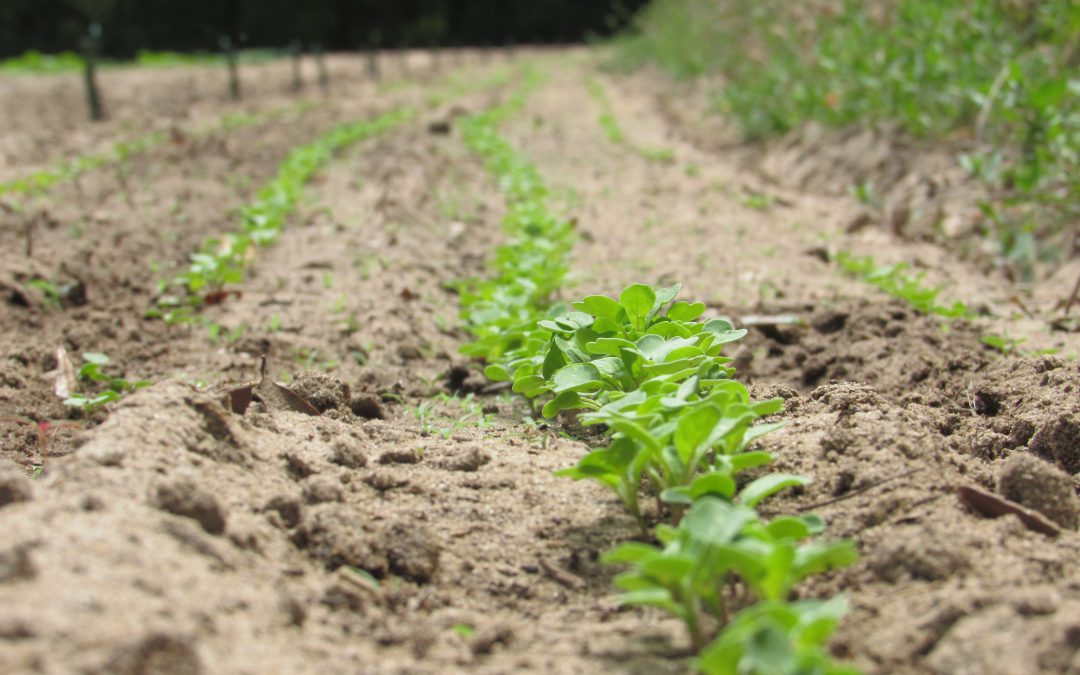
by Evan Anderson | Jul 22, 2021
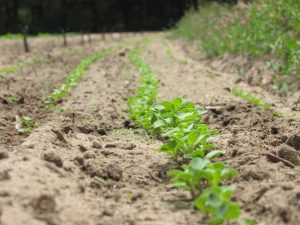
A good garden takes some time and effort!
Gardening in North Florida can be a challenge. Conditions in the panhandle are very different than in most other locations in the country, and learning what and how to grow takes time! Here are a few tips to help the aspiring gardener adapt to the unique climate and soils here.
- Know Your Varieties
Not every variety of vegetable is the same. Some differences may be obvious – a purple cabbage isn’t hard to distinguish from a green one, and a cherry tomato will never be mistaken for a beefsteak. Other differences are not so obvious, and you may have to do some research to figure out what you’re getting with a particular cultivar. Some are better adapted to growing in the heat, or may have resistances to certain diseases or pests. See the Florida Vegetable Gardener’s Guide (https://edis.ifas.ufl.edu/publication/VH021) or the Vegetable Production Handbook of Florida (https://edis.ifas.ufl.edu/publication/CV292) for varieties that do well in Florida.
- Light is Your (Plants’) Friend
Space for a garden is often limited, but remember that light can’t be! A shady location leads to unhappy vegetables. Plants produce energy by absorbing the rays of the sun, and garden plants need a lot of light to make the food we eat. If your plants are looking spindly and not producing well, look up and see what’s shading them. If possible choose a location for your garden that gets at least six hours of full sun each day. Even more is better!
- Plant at Proper Times
There are really two growing seasons in North Florida: spring and fall. It gets too cold for most plants in the winter, and tropical plants will especially suffer. The heat of the summer is similarly hard on a garden. Few plants can continue producing their best in the face of such high heat and humidity. Okra and peppers might soldier on through the heat, but cool-weather loving crops like peas, lettuce, and broccoli will meet defeat. Know what temperatures each plant prefers and plan your garden accordingly. Consider starting transplants indoors early to get the most growing time possible – February or March is a good time to start transplants in the spring, and September in the fall.
- Watch your Watering
Even watering is important for crops, and the weather rarely cooperates. The occasional drought followed by a ten inch rain can make managing irrigation a headache, but try to keep up with the weather! Remember that warmer weather causes more evaporation, and larger plants take up more water. That being said, a ten-inch rain during the summer will probably supply all the water your plants need for the day, so consider turning off the irrigation when it rains. It’s just as possible to overwater as it is to let plants dry out too much.
- Be Wise When you Fertilize
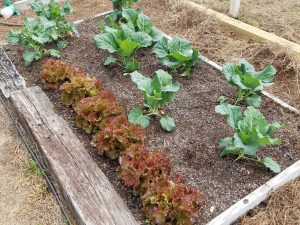
A raised bed is a good choice for gardening where soil is particularly sandy.
The soil in much of our area is very sandy. In some places, it’s nothing but! Highly sandy soils don’t hold on to much in the way of water or nutrients, so the gardener needs to balance their inputs to adjust for this fact. Get your soil tested so you know what nutrients are in the soil (your local Extension office can help with that). When you do fertilize, don’t dump all your plants need for the year on at once! Chances are, much of it will just wash away in the next rain. Instead, split your fertilization up into several applications over the growing season. Try also using slow-release fertilizers or organic sources of nutrients that break down over time and feed plants. You can also amend your soil with organic matter (things like compost and manure are good sources) to help add some nutrient-holding capacity. Organic matter can also help deter sandy-soil-loving nematodes, which are microscopic worms that can damage the roots of plants.
- Scout for Pests and Diseases
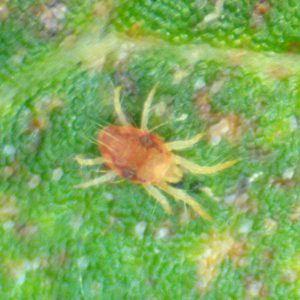
Spider mites are a tiny, but common garden pest.
Florida’s climate makes it very attractive not just for retirees, but also for all sorts of plant pests and diseases as well. Keep a close eye on your garden and deal with anything out-of-the-ordinary before a problem becomes overwhelming. Pests of all sorts, whether they are weeds, insects, or fungi, are much easier to eliminate when they’re young or in small numbers. Remember that not everything is a plant pest – some insects are beneficial predators that can keep the enemies at bay, so don’t always immediately reach for a chemical that’s going to kill everything. Natural and biorational options such as neem oil, Bacillus thuringiensis or Bt, insecticidal soap, or diatomaceous earth can work just as well as other pesticides, and can help avoid harm to pollinators and beneficials. Know the pest you’re treating before you try getting rid of it! See our EDIS publication on natural garden products (https://edis.ifas.ufl.edu/publication/IN197) for more information.
Remember not to get discouraged! If you need help figuring out what’s going wrong in your garden, you can always talk to the folks at your local Extension office. There’s also plenty of other information out there – look for our other EDIS publications on a variety of topics (https://edis.ifas.ufl.edu/). Happy gardening!

by Larry Williams | Jul 15, 2021
Q. One of my two fig trees has produced a few figs. The other one, which is the largest and healthiest tree, has never had a fig on it. Both where planted six years ago. Why is it not producing?
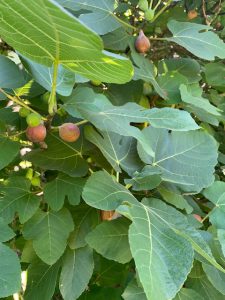
Mature fig tree with fruit. Photo credit: Larry Williams
A. It may be a matter of age and being overly vigorous. When a fruit tree is younger, it puts most of its energy into producing leaves and shoots. Until the plant becomes mature and slows down in the production of leaves and shoots, it will produce few to no fruit. It may take a year or two more for your tree to slowly and gradually switch from producing mostly leaves and shoots to producing and maturing some fruit. Patience is needed.
Be careful to not overdo it in fertilizing and/or pruning your fig tree. Too much fertilizer, especially nitrogen, or severely pruning the tree will result in the tree becoming overly vigorous at the expense of setting and maturing fruit. This includes fertilizer that the tree may pull up from a nearby lawn area. A tree’s roots will grow outward two to three times beyond its branch spread into adjacent lawn areas.
The end result of being heavy handed with fertilizing and/or overdoing it in pruning is the same – it forces the plant to become overly vigorous in producing leaves and shoots at the expense of producing and maturing fruit.
In addition, the following is taken from an Extension publication on figs and includes the most common reasons for lack of fruiting, in order of importance.
- Young, vigorous plants and over-fertilized plants will often produce fruit that drops off before maturing. If plants are excessively vigorous, stop fertilizing them. Quite often, three of four years may pass before the plant matures a crop because figs have a long juvenile period before producing edible quality fruit.
- Dry, hot periods that occur before ripening can cause poor fruit quality. If this is the case, mulching and supplemental watering during dry spells will reduce the problem.
- The variety Celeste will often drop fruit prematurely in hot weather regardless of the quality of plant care. However, it is still a good variety to grow.
- An infestation of root-knot nematodes can intensify the problem when conditions are as described in item 2.
- You could have a fig tree that requires cross-pollination by a special wasp. This is a rare problem. If this is the case, then it will never set a good crop. The best way to resolve this is to replace the plant with a rooted shoot of a neighbor’s plant you know produces a good crop each year.
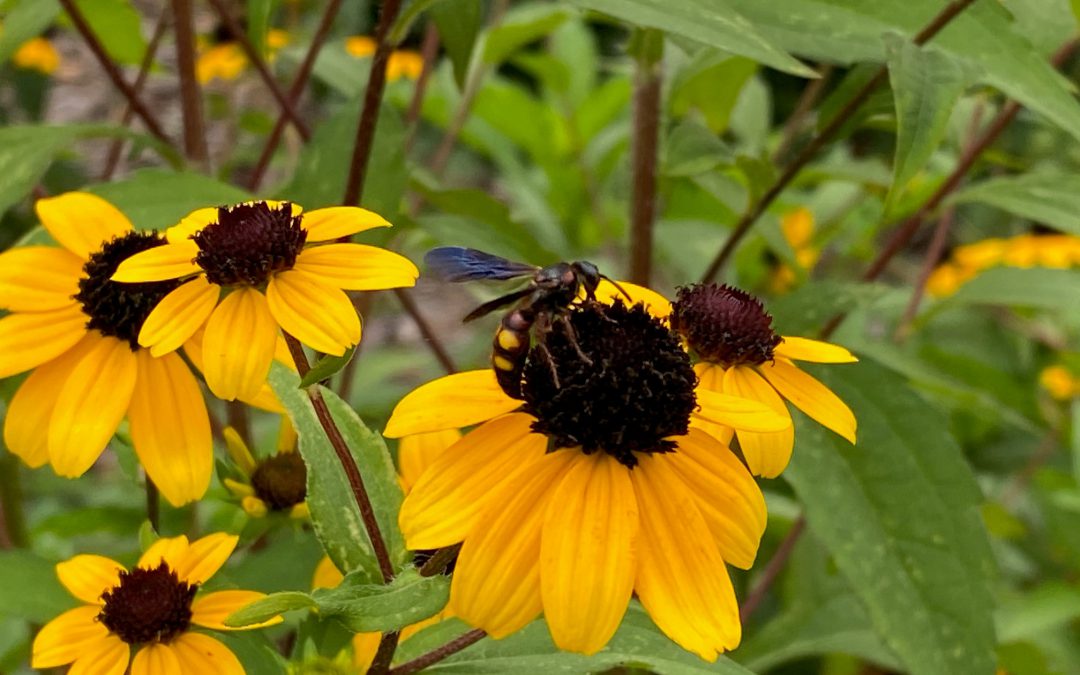
by Mary Salinas | Jul 15, 2021
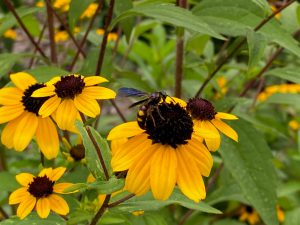
Brown-eyed Susan makes a nice addition to a pollinator garden. This one is visited by a scoliid wasp, a parasitoid of soil-inhabiting scarab beetle larvae. Photo credit: Mary Salinas, UF/IFAS Extension.
Black-eyed Susan, Rudbeckia hirta, has been a very popular garden perennial for generations. Fewer gardeners have experience with, or even heard of its’ close relative, brown-eyed Susan, Rudbeckia triloba. So, what is the difference between them?
- Brown-eyed Susan has more numerous flowers and generally flowers for a longer period in spring, summer, and fall.
- Black-eyed Susan has bigger flowers and bigger leaves.
- Both species are perennial, but the brown-eyed Susan tends to die out sooner after a few years. The good news is that both readily spread through seed to replace older plants.
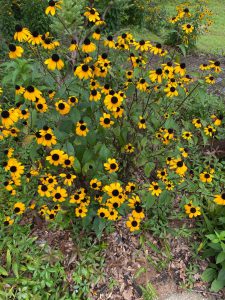
Brown-eyed Susan. Photo credit: Mary Salinas, UF/IFAS Extension.
Brown-eyed Susan is native to the eastern and central United States and, although native to Florida, it has only been vouchered in the wild in 5 counties in Florida. Gardeners can find seed and plants readily online and at a few native plant nurseries. It is best to try to source wildflower seed from plants grown in the same region. Brown-eyed Susan seed from plants grown in Nebraska or Michigan may not be as well adapted to the Florida environment as locally grown seed.
If you want to add this pollinator attracting perennial to your garden, choose a spot that is sunny or partly sunny. Although it prefers moist soil, brown eyed Susan adapts to most soil types and is drought tolerant after establishment.
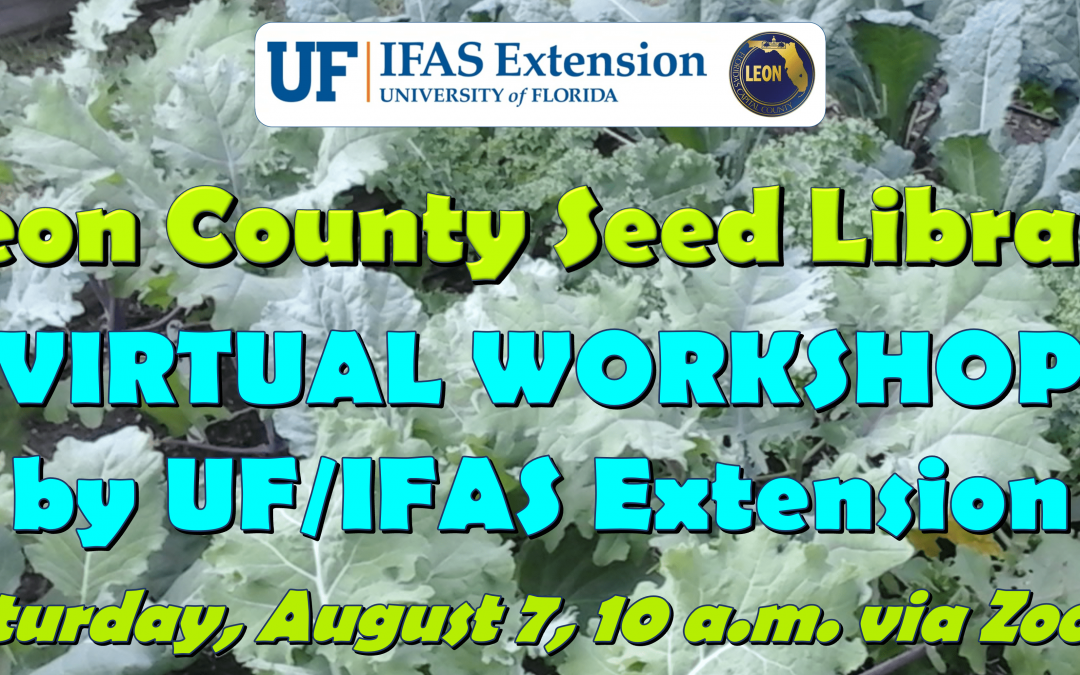
by Molly Jameson | Jul 15, 2021
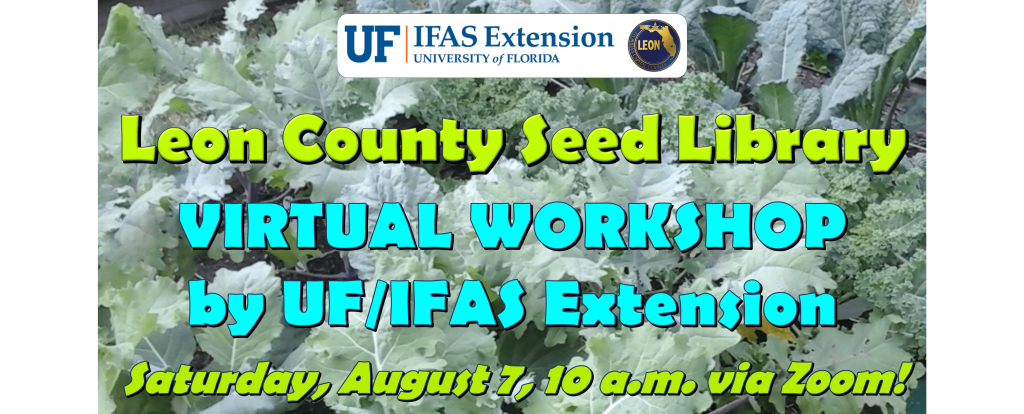
Join us via Zoom on Saturday, August 7, for our Leon County Seed Library Virtual Workshop. Graphic by Molly Jameson.
Join Us August 7 for the 2021 Leon County Seed Library Virtual Workshop
Planting vegetable seeds and growing a garden is a great way to get outdoors and appreciate nature. Since 2015, the Leon County Public Library has supported gardeners in Leon County by providing vegetable seed packets for patrons to take home and plant in their gardens.
To kick off the Fall 2021 Seed Library, agents with UF/IFAS Leon County Extension are hosting the Leon County Seed Library Virtual Workshop on Saturday, August 7, from 10:00 a.m. to 12:00 p.m. via Zoom.
During the virtual workshop, Extension agents will discuss planting seeds, growing vegetables, and how to incorporate veggies into healthy meals and snacks. The workshop coincides with the first day the seeds in the Fall 2021 Seed Library will become available. Residents of Leon County can check out three sample seed packets per month with their library cards from all Leon County library branches.
Even if you are not a resident of Leon County, everyone is welcome to join us at the virtual workshop. Along with the gardening portion of the workshop, there will also be a live virtual cooking demonstration featuring vegetables available in the Fall 2021 Seed Library Program.
For more information about the Leon County Seed Library Virtual Workshop, please visit our Eventbrite page: https://seedlibraryworkshop2021.eventbrite.com. There is no cost to attend the workshop, but registration is required.
If you are a resident of Leon County, all you need is your Leon County library card to check out the vegetable seeds. Don’t have a library card? No problem! Leon County residents can apply online at the LeRoy Collins Leon County Public Library online card application page here: https://lcpl.ent.sirsi.net/custom/web/registration/.
Here is the list of the vegetable seed varieties that will be available starting August 7: Common Arugula, Waltham 29 Broccoli, Chantenay Red Core Carrots, Michihili Chinese Cabbage, Slo-bolt Cilantro, Alabama Blue Collards, Early White Vienna Kohlrabi, Rocky Top Salad Blend Lettuce, Pink Beauty Radishes, and Tokinashi Turnips.
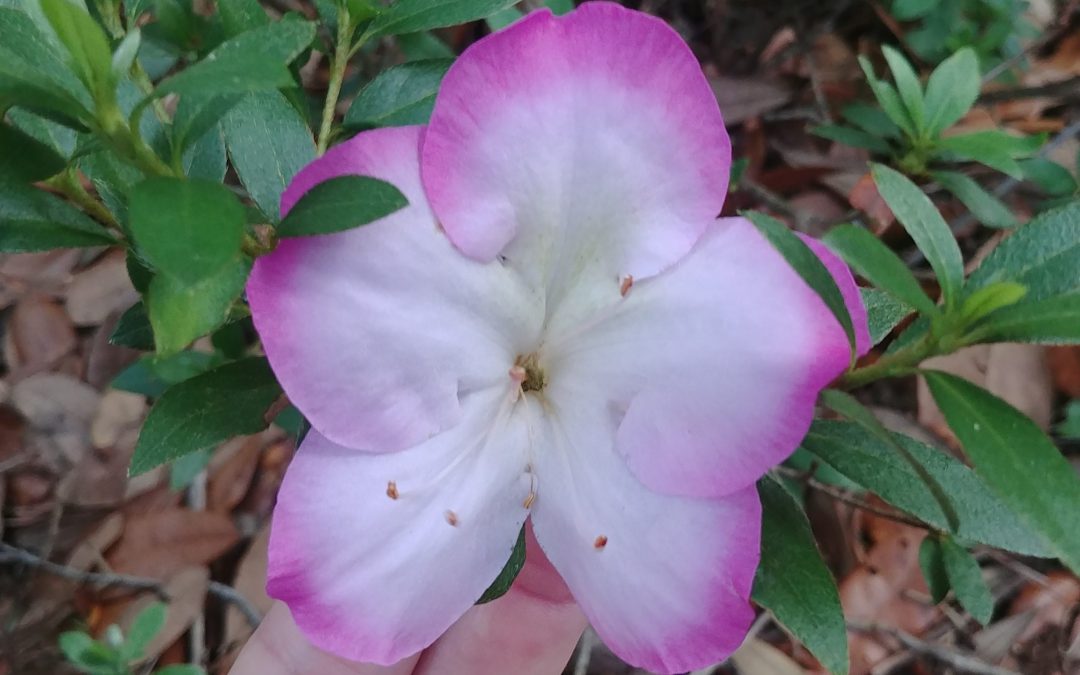
by Matt Lollar | Mar 25, 2021
Article written by Dr. Gary Knox, North Florida Research & Extension Center – Quincy, FL.
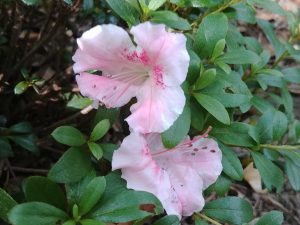
‘Gumpo Pink’ flowers are 3 inches in diameter and are pink with purplish pink dots and occasional white blotches on petals.
Background
In the times before re-blooming azaleas like Encore®, Bloom-A-Thon® and others, Satsuki azaleas were valued for late flowering that extended the azalea “bloom season”. Even with modern re-blooming azaleas, Satsuki azaleas still are appreciated as refined evergreen shrubs for the sophisticated garden or discerning plant collector.
“Satsuki” means “Fifth Month” in Japanese, corresponding to their flowering time in much of Japan. These azaleas were developed hundreds of years ago from their native Rhododendron indicum and R. eriocarpum. The Japanese selected cultivars more for their form and foliage than for flowering. These beloved plants were used in gardens as sheared boxwood-like hedges or pruned into rounded mounds that might resemble rocks or boulders in classical Japanese gardens. Their size and form also made them well adapted for training as bonsai. Most of the Satsuki azaleas in America were introduced in the 1930s by USDA.
Description
Satsuki azaleas are small evergreen shrubs that flower in April and May in north Florida, long after most older type azaleas have finished. Satsuki azaleas also are known for producing large, mostly single flowers up to 5 inches in diameter in colors of white, pink, red, reddish orange and purple. Often the flowers will include stripes, edging, blotches, spots or flecks of contrasting colors (Sometimes all on the same plant!) with more than 20 different color patterns recorded.
Satsuki azaleas have an elegant subtle charm, quite unlike the flashy, over-the-top, heavy blooming all-at-once Southern Indica azaleas like ‘Formosa’ and ‘George L. Taber’. Typically, Satsuki azaleas display a few large blooms at a time, allowing one to better appreciate their size and color patterns as contrasted against their fine-textured, dark green leaves. To make up for a less boisterous display, Satsuki azaleas flower over a longer timeframe, averaging about 8 weeks, with some flowering an amazing 14 weeks. In another contrast, most Satsuki azaleas grow smaller in size, in my experience reaching about 3 feet tall and wide in a five-year timeframe. The rounded to lance-shaped leaves of Satsuki azaleas also are demure, ranging in length from just ½ inch to no more than 2 inches.
Culture
Satsuki azaleas enjoy the same conditions as most other azaleas: light shade and moist, rich, well-drained soil. Mulch regularly to maintain organic matter and help hold moisture. Fertilize lightly and keep the roots evenly moist. Minimal to no pruning is required. Satsuki azaleas also are well adapted to container culture. Their small size and fine textured leaves make these a favorite for bonsai enthusiasts since their small leaves, branching habit and mounded form naturally make them look like miniature mature “trees”.
Sources and Cultivars
Look for Satsuki azaleas in spring at garden centers or year-round at online nurseries. There are hundreds of cultivars but some popular types to look for include:
Gumpo Pink – 3-in. diameter light pink flowers with purplish pink dots and occasional white blotches
Gumpo White – 3-in. diameter white flowers with occasional pink flakes and light green blotches
Gyokushin – 3-in. diameter flowers are predominantly white but with light to dark pink dots and blotches
Higasa – flowers are 4 to 5 inches in diameter and are purplish pink with purple blotches
Shugetsu – also called ‘Autumn Moon’, 3-in. diameter flowers are white with a broad, bright purplish-red border
Tama No Hada – flowers are 4 to 5 inches in diameter and are white to pink with deep pink stripes; usually flowers in fall as well as spring
Wakaebisu – 2.5-in. diameter flowers are “double” (hose-in-hose) and are salmon pink with deep pink dots and blotches; this also flowers in fall as well as spring
References:
Chappell, M. G.M. Weaver, B. Jernigan, and M. McCorkle. 2018. Container trial of 150 azalea (Rhododendron spp.) cultivars to assess insect tolerance and bloom characteristics in a production environment. HortScience 53(9-S): S465.
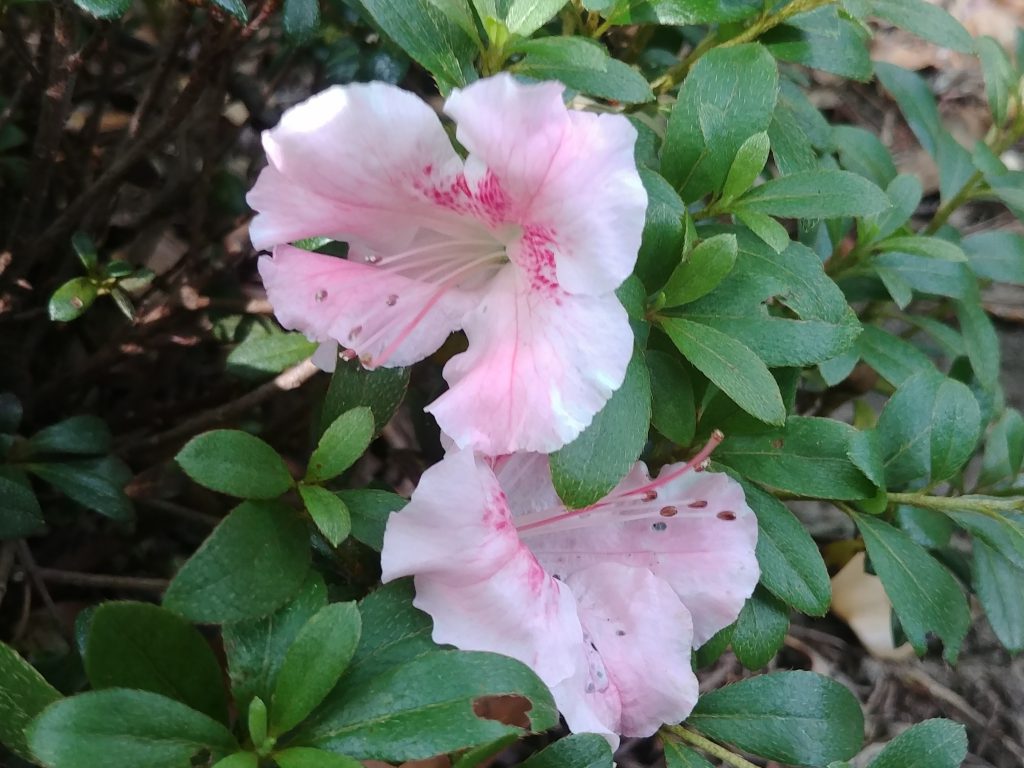
‘Gumpo Pink’ flowers are 3 inches in diameter and are pink with purplish pink dots and occasional white blotches on petals.
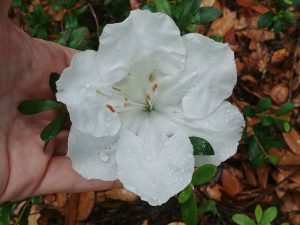
‘Gyokushin’ flowers are white with occasional pink flecks and light green blotches.
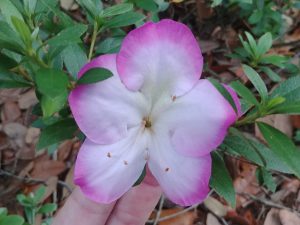
‘Shugetsu’ has 3-inch flowers that have bright purplish-red border on edges of petals.
Galle, Fred C. Azaleas. 1985. Timber Press, Portland, Oregon. 486 pp.
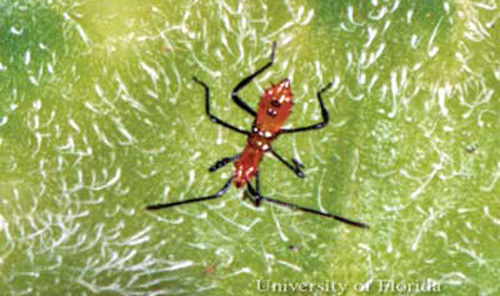
by Matthew Orwat | Mar 25, 2021
Stinkbugs and their relatives are not always problematic in the flower or vegetable garden, but when they become so, they can suck the life out of our fruits and vegetables, create ugly abrasions, and destroy flowers such as roses.
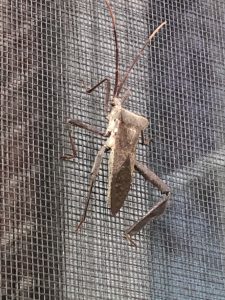
Over-wintering adult leaffooted bug emerging from hibernation . Image Credit Matthew Orwat, UF / IFAS Extension
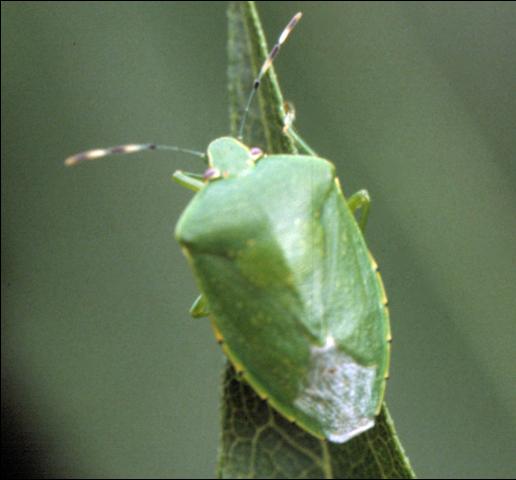
The green stink bug Acrosternum hilare (Say). Image and caption credit EDIS, Dr. Russ Mizell
What is a Stink Bug?
The stink bug (Pentatomidae family) is a major garden pest of a variety of fruits and vegetables including squash, peppers, tomatoes, peaches, plums, pecans and a variety of other edibles. They are known as a “piercing and sucking” insect because that’s the way they feed, by using their mouth, or proboscis, just like a needle to pierce the fruit and suck out the juices. This feeding leaves a damaged area of the fruit which may develop discoloration, rot or fungal disease and render the fruit unsaleable or inedible.
Who are “their relatives”
The leaf footed bug, Leptoglossus phyllopus (L), is a relative of the stinkbug and feeds in the same way, has a similar lifecycle and causes similar damage. They are usually slightly larger and have “leaf like” appendages on their legs which are their namesake.
What is their lifecycle?
In Florida, overwintering adult stink bugs will place a clutch, or tight group of eggs, on a host plant early in the growing season. If their preferred plant is not available, they use a variety of weeds and grasses to lay eggs upon and provide food for their young. After eggs hatch, they go through several nymph stages before they finally reach the adult stage. Stink bugs have multiple generations in a year, often four to five. They readily move to find preferable food sources and might appear in a garden without warning to feed and cause destruction.

Nymph of the leaffooted bug, Leptoglossus phyllopus (L.). Photograph by Lyle J. Buss, University of Florida.
How are they best controlled?
First of all, many stink bugs use weeds as host plants to gather and feed upon, so controlling weedy plants around vegetable and fruit gardens might limit their numbers. If stink bugs are a major problem, planting trap crops, such as sunflowers, is beneficial. Stink bugs prefer to feed on sunflowers more than some other vegetables. This situation can be used to the gardener’s advantage by mechanically killing or spraying stink bugs on trap crops while avoiding treating food crops with pesticides. More information on trap cropping can be found here.
Additionally, stink bug traps are available. These mechanically trap stink bugs, thus reducing their numbers in the garden, but need to be monitored and serviced regularly. Several species of parasitic Tachinid flies are also predators of stink bugs. These flies lay their eggs on adult stink bugs. The fly larva use the bug as a buffet, slowly killing the bug.
Stink bugs are difficult to control with insecticides, but some measure of control can be achieved at their nymph stage with various approved fruit and vegetable insecticides containing pyrethrins. These products are readily available at local garden centers and feed & seed stores.
For more information, please check out the following resources:



















